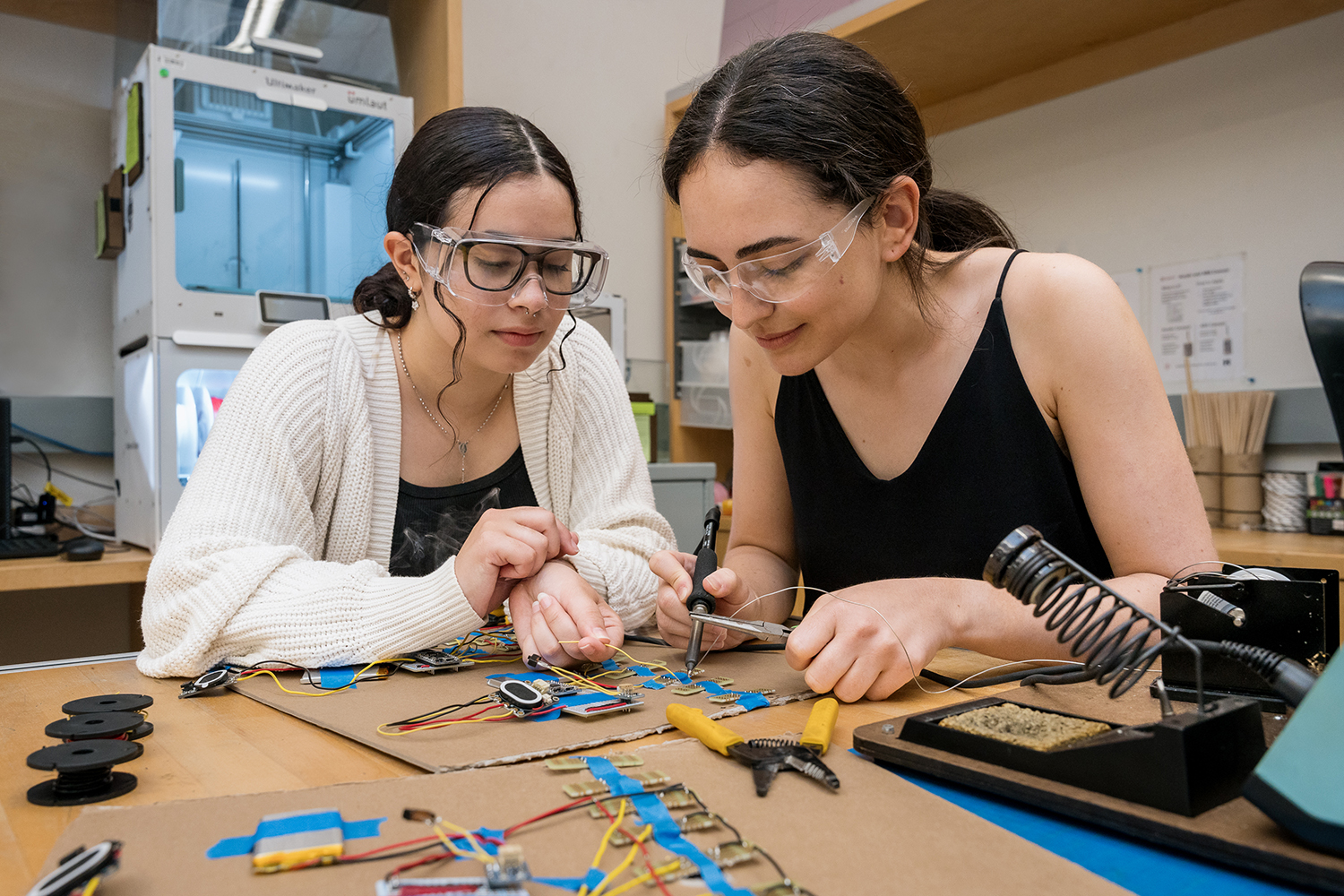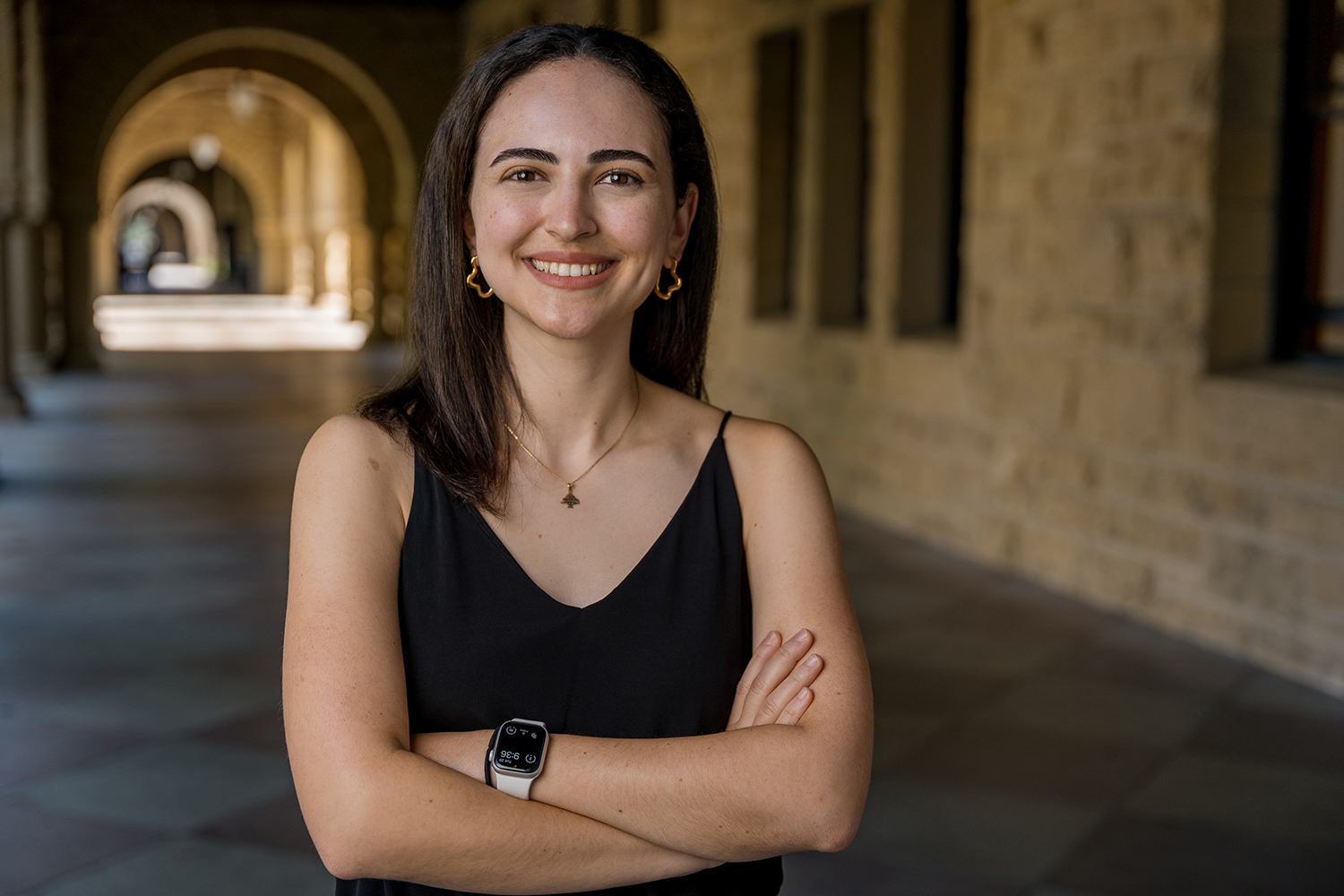Engineering accessibility
RAISE doctoral fellow Aya Mouallem is designing an electronic circuit simulator that uses a mix of haptic and digital components to allow blind and low-vision engineering students to collaborate with sighted colleagues.

RAISE fellow Aya Mouallem (right) explores new ways for engineering students with blindness or low vision to simulate circuits and collaborate with their lab colleagues. (Image credit: Alex Gillaspy)
Simulating the design of electronic circuits is a fundamental skill for electrical engineering students. Most simulators have the user drag and drop design components on a computer screen. But this can create barriers for students with blindness and low vision.
Aya Mouallem, a PhD candidate in electrical engineering and a fellow with Stanford’s Research, Action, and Impact through Strategic Engagement Doctoral program (RAISE), wants to change that.
Working in the Designing Education Lab at Stanford, Mouallem is designing an accessible electronic circuit simulator that uses a mix of haptic and digital components, with both tactile and audio feedback.
“I’m hoping it will be a new way for blind learners to independently simulate their circuits and also collaborate in the lab with others who are sighted,” she said.
Tools need to be accessible to blind students but also usable by a sighted person – so that an instructor can offer feedback on the student’s work, for example, and other students can collaborate.
“3D modeling is a really big problem for blind folks who want to get into mechanical engineering,” said Gene Kim, a junior majoring in symbolic systems, who is blind. He has been working with Mouallem in the Designing Education Lab and helped with the design criteria for the circuit simulator. He initially wanted to study mechanical engineering but turned to computer science because it was more accessible.
With a tool like this one, “people would be more inclined to study mechanical engineering and electrical engineering,” Kim said. “I think people would be a lot less burned out and stressed from having to come up with creative ways to work around the accessibility challenges.”
Fellowships that support community engagement
Mouallem’s work is partially supported by the RAISE Doctoral Fellowship program. She is also a Knight-Hennessy Scholar.
“Many of our students are strongly motivated to connect their research or scholarship to action, but not all have a pathway nor the support to do so.”
—Stacey F. Bent
Vice Provost for Graduate Education and Postdoctoral Affairs
The three-year fellowship provides tuition and a stipend as well as money to be spent on the fellow’s project. Students in each cohort meet during biweekly lunches to learn from each other and from guest speakers about topics ranging from identifying and developing community partnerships to ethics in community-based research.
The program, which was announced in 2021, was started to provide doctoral students across disciplines with an opportunity to explore community impact or public service.
“Many of our students are strongly motivated to connect their research or scholarship to action, but not all have a pathway nor the support to do so,” said Stacey F. Bent, vice provost for graduate education and postdoctoral affairs. “I hope [this program] will help educate a generation of doctoral students who have experienced the satisfaction of public service and community partnerships, who have learned how to be effective, ethical, and respectful community partners in the future, and can share this knowledge with others.”
Mouallem, who had her own hereditary vision loss corrected with surgery, realized that it would not be effective for her as a sighted person to design the tool she thought blind and low-vision users needed.
“I had to co-design with the community,” Mouallem said. “I wanted to work on research that was still pushing the envelope academically but at the same time was working with communities, amplifying their voices and building something they could use in their everyday lives.”
This approach is “part of a bigger wave of designing ‘with’ as opposed to designing ‘for,’” said Sheri D. Sheppard, the Richard W. Weiland Professor in the School of Engineering, Emeritus, and Mouallem’s advisor. “How can we understand at a deeper level what a community’s issues are, what knowledge they already have, and develop more effective resources for learning?”
Community partners
A key component of the RAISE Fellowship is working with a community partner and for Mouallem, this is LightHouse, a nonprofit that serves the blind and low-vision community.
Mouallem spent this past summer building prototypes of the circuit simulation tool with undergraduate researcher Mirelys Mendez-Pons. Now she and the LightHouse team are planning a session for members of the blind and low-vision community to give feedback about the tool, as well as meet blind students and allies at Stanford.
“I’m still very much in engineering. But now I’m directly seeing its impact with people vs. designing a chip and waiting years for it to be incorporated into a product.”
—Aya Mouallem
“Oftentimes things are made accessible after the fact,” said Sean Dougherty, accessible user experience services director for LightHouse. “But when the community is actively involved throughout the process, it always ends up being a much better experience.”
Mouallem said the fellowship has changed her graduate experience.
“I’m still at the lab, building things and soldering. I’m still very much in engineering,” Mouallem said. “But now I’m directly seeing its impact with people vs. designing a chip and waiting years for it to be incorporated into a product.”
Broader ambitions
Mouallem’s work aims to break down barriers not only at Stanford but in education – and the field of engineering – more broadly.
“Before RAISE, I did not know the extent to which you could delve deep in understanding human experiences and design for human needs,” Mouallem said. “Now I’m shocked at how many products are released into markets without anyone talking to the communities the products are intended for.”
